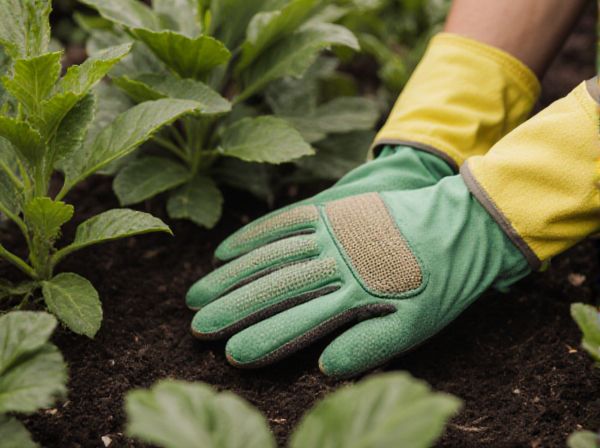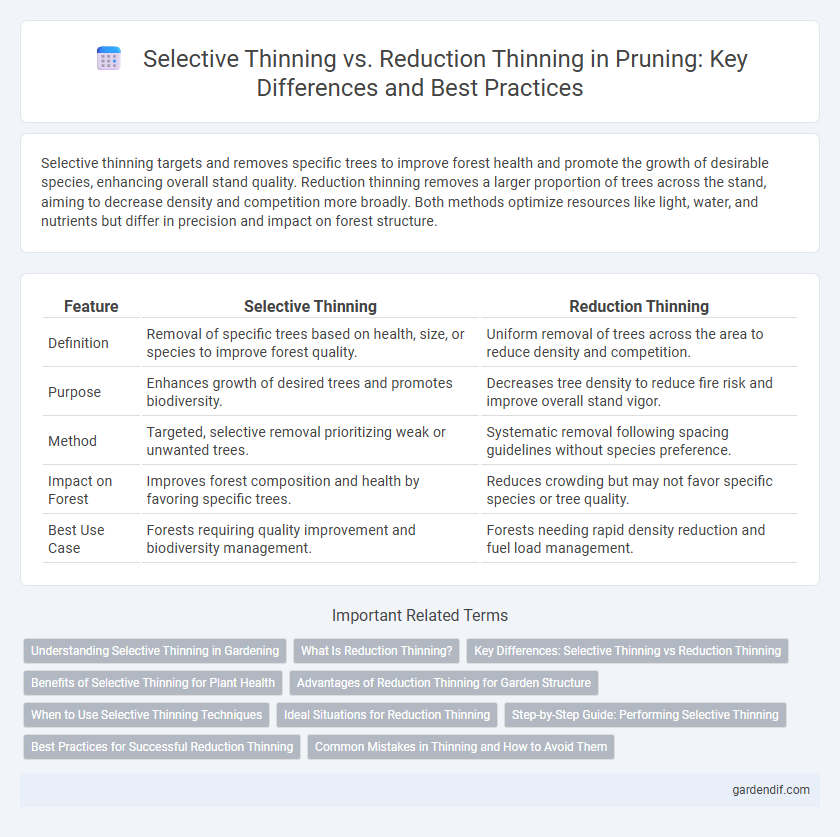
Selective thinning vs reduction thinning Illustration
Selective thinning targets and removes specific trees to improve forest health and promote the growth of desirable species, enhancing overall stand quality. Reduction thinning removes a larger proportion of trees across the stand, aiming to decrease density and competition more broadly. Both methods optimize resources like light, water, and nutrients but differ in precision and impact on forest structure.
Table of Comparison
| Feature | Selective Thinning | Reduction Thinning |
|---|---|---|
| Definition | Removal of specific trees based on health, size, or species to improve forest quality. | Uniform removal of trees across the area to reduce density and competition. |
| Purpose | Enhances growth of desired trees and promotes biodiversity. | Decreases tree density to reduce fire risk and improve overall stand vigor. |
| Method | Targeted, selective removal prioritizing weak or unwanted trees. | Systematic removal following spacing guidelines without species preference. |
| Impact on Forest | Improves forest composition and health by favoring specific trees. | Reduces crowding but may not favor specific species or tree quality. |
| Best Use Case | Forests requiring quality improvement and biodiversity management. | Forests needing rapid density reduction and fuel load management. |
Understanding Selective Thinning in Gardening
Selective thinning in gardening involves carefully removing specific branches or stems to enhance the overall health and growth of plants by allowing better air circulation and light penetration. This method targets weaker or overcrowded parts of the plant, promoting stronger development and reducing disease risk. Unlike reduction thinning, which cuts back the size of the plant, selective thinning maintains the natural shape while improving structural integrity.
What Is Reduction Thinning?
Reduction thinning is a pruning technique aimed at decreasing branch density by selectively removing entire branches or shoots, improving light penetration and air circulation within the tree canopy. This method targets congested areas to reduce crown weight and stress, thereby enhancing overall tree health and structural integrity. Reduction thinning differs from selective thinning by focusing more on branch length and thickness reduction rather than simply removing smaller, competing branches.
Key Differences: Selective Thinning vs Reduction Thinning
Selective thinning focuses on removing specific trees to enhance the growth and health of chosen specimens, targeting poorly formed or less desirable trees to improve overall forest quality. Reduction thinning decreases stand density more broadly, aiming to reduce competition for resources across the entire stand to increase growth rates and reduce fire hazards. The key difference lies in selective thinning's targeted approach versus reduction thinning's emphasis on overall density management.
Benefits of Selective Thinning for Plant Health
Selective thinning enhances plant health by strategically removing weaker or overcrowded branches, which improves air circulation and light penetration within the canopy. This targeted pruning reduces the risk of disease and pest infestation by minimizing moisture retention and promoting healthy growth. Improved resource allocation to remaining branches supports stronger structural integrity and increased fruit or flower production.
Advantages of Reduction Thinning for Garden Structure
Reduction thinning enhances garden structure by strategically removing entire branches or shoots, promoting better air circulation and light penetration within the canopy. This method helps maintain the natural shape and overall balance of plants, preventing overcrowding and reducing the risk of disease. Selective removal also encourages robust growth of remaining branches, supporting a healthier, more aesthetically pleasing garden framework.
When to Use Selective Thinning Techniques
Selective thinning techniques are ideal when the goal is to improve individual tree growth, health, and form by removing specific trees that compete with high-value or well-formed trees. This method is most effective in uneven-aged forests or stands where maintaining a diverse structure and maximizing timber quality are priorities. Use selective thinning when precise control over tree spacing and species composition is necessary to enhance forest resilience and productivity.
Ideal Situations for Reduction Thinning
Reduction thinning is ideal in dense, overcrowded stands where lowering tree density improves light penetration and resource availability, promoting healthier growth. It focuses on removing smaller, suppressed, or poorly formed trees to allocate resources to dominant individuals, enhancing overall stand structure and productivity. This method suits forest areas aiming to restore balance and optimize timber quality without significantly altering species composition.
Step-by-Step Guide: Performing Selective Thinning
Selective thinning involves carefully removing specific branches to improve tree structure and light penetration, targeting crowded or crossing limbs. Begin by identifying and cutting branches that negatively impact airflow or growth direction, using sharp, clean pruning shears to make precise cuts close to the branch collar. Focus on maintaining the tree's natural shape while enhancing overall health by selectively removing weaker or competing branches rather than reducing the tree's overall size.
Best Practices for Successful Reduction Thinning
Selective thinning focuses on removing specific trees based on species, size, or health to enhance forest structure, while reduction thinning aims to decrease stand density uniformly to improve overall growth and health. Best practices for successful reduction thinning include conducting a thorough site assessment to identify target trees, ensuring residual stand spacing supports optimal growth, and timing interventions to minimize stress on remaining trees. Employ adaptive management strategies by monitoring post-thinning conditions to guide future treatments and maintain ecosystem balance.
Common Mistakes in Thinning and How to Avoid Them
Common mistakes in thinning include removing too many dominant trees during selective thinning, which can reduce forest growth potential, or applying reduction thinning inaccurately, leading to over-dense stands that increase disease risk. Avoid these errors by accurately assessing tree health, stand density, and growth goals before thinning, and by following site-specific thinning guidelines based on tree species and forest type. Proper thinning techniques enhance canopy structure, improve sunlight penetration, and promote sustainable forest regeneration.
Selective thinning vs reduction thinning Infographic

 gardendif.com
gardendif.com